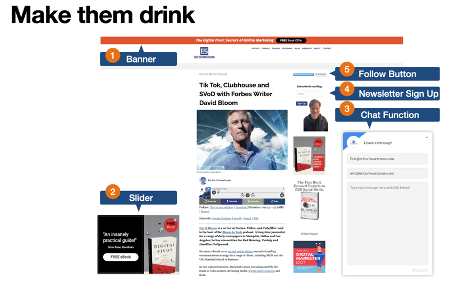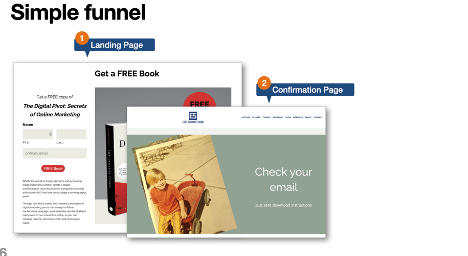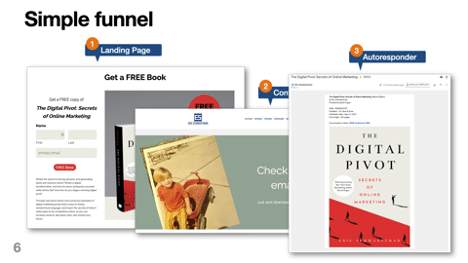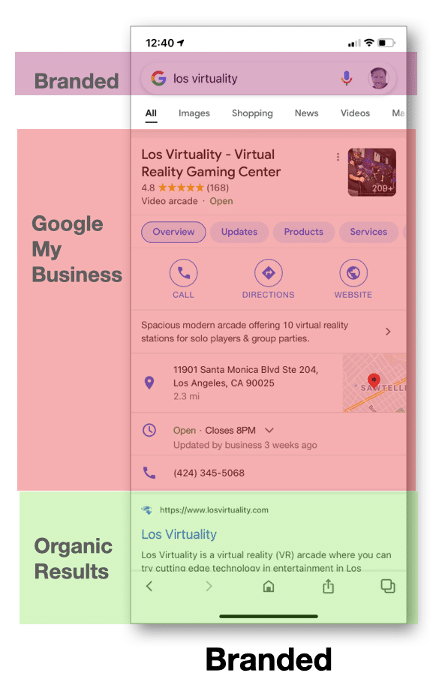

Guest Post by Eric Schwartzman – There’s a lot of confusion about what digital marketing is. If you sat the digital marketing revolution out cause you were running your business, I get it. In this post, I’m going to break down digital marketing for you. Like a dance, digital marketing is a series of steps taken in a specific order.
I was vice president of marketing at Laser Storm, which Bob Cooney and I took public on the NASDAQ exchange. So I have a good deal of experience in the amusement industry marketing attractions. So when he booked me to be the digital marketing keynote speaker at Amusement Expo International, I was excited to frame what’s happening in digital marketing for a sector of the small business community that’s part of the backbone of our economy.
Digital marketing is the California Gold Rush of the modern ages. Of the thousands who set out to stake their claim, very few found gold. But some made fortunes selling picks and shovels. Today, there are more digital gurus selling advice than there are businesses making money online.
It’s not social media, Google, or Facebook ads. Those are just tactics.
Digital marketing is leading a horse to water and making them drink. Only you’re leading them to your website, and getting them to buy or sign-up for something.

But when they visit your website – regardless of how they get there – your goal is to convert them into customers. Digital marketing is about tunnels and funnels. Think of it like building inbound tunnels to your marketing funnels.
Not all horses drink. And not all website visitors convert. The four marketing funnel stages we go through when we’re deciding whether or not to buy are:
You have to cover all four bases to get the customer to home plate. Otherwise, you have a leaky funnel. And if your funnel leaks, the horses wander away and drink somewhere else.
The dirty little secret about digital marketing that no one wants to tell you is this. Social media and content marketing are just pieces of a much larger puzzle. You need to understand how they fit together.

These are five ways people get to your website without buying ads. The first is organic search, which means unpaid traffic from Google. These aren’t pay-per-click ads. They’re the actual search results you get from Google’s algorithm. For this client, traffic from organic search resulted in $43,774 in sales.
The second path is Direct traffic which really means unknown. Direct traffic is traffic to your website from an unverified source. So this metric should be taken with a grain of salt.
The third path is email marketing. These are people who gave us permission to send them emails. And we generated $52,046 in sales through direct-to-consumer email marketing campaigns.
The fourth path is people that clicked a link that was shared on a social network. They saw something shared on Facebook or Instagram and clicked through to the client’s website and made a purchase.

And the fifth path are referral links published on someone else’s website, like news articles and blog posts. It’s the equivalent of digital PR. I have a white paper on how to get press if you want to get referral links. After I left Laser Storm, I was director of promotions at one of the largest PR firms. But in this case, you can see that we did $30,078 through referrals.
In total, my client generated $194,399 in revenue attributed to these sources without buying a single ad. No Google ads. No Facebook ads. No online travel agency commissions! Since they pivoted to digital, their online revenue has grown to become a third of their bottom line.
If you’re selling considered purchases like VR attractions to business owners, you’re going to be generating leads rather than revenue online. Here’s my B2B lead generation guide if that’s you.
In digital marketing, these are the paths we use to lead a horse to water.
But it’s not enough to lead a horse to water. You have to make them drink too. It’s entirely possible to rank high in Google search and have tons of followers on social media and make zero money from it.
Content creator burnout is a thing now. So you have to have something to sell. And you have to make it easy for horses to drink. You have to convert visitors to your website into customers.
Conversion optimization — which is the art and science of turning website visitors into customers — is one of my specialties. Here are five common ways digital marketers convert website visitors into customers.

As I mentioned earlier, your website is your sales funnel. It’s how you convert awareness into consideration into transactions. Let’s say you’re searching for something. It could be anything. Maybe you want to know how to market your VR attraction on Tik Tok.
So you search the phrase “Tik Tok Marketing” and you find this blog post on my website. You’re reading it, and (1) a banner appears at the top with an offer for a free book about digital marketing.
You ignore it and continue reading, and 2 minutes later, another (2) ad slides in on the bottom left. It’s unobtrusive. It doesn’t cover the article you’re reading. But it’s another free book offer, this time with an image and a testimonial.
If you want to ask a quick question, there’s also a (3) live chat option. Or if you’re early in the buying process and not quite ready to talk to someone, but you still want to learn more about digital marketing, there’s an option to (4) subscribe to a newsletter. And if none of these converts, there’s a (5) Twitter follow button as well.
Email subscribers are more valuable than Twitter followers because you’re not dependent on a social network to contact them. You can contact them directly through email. But let’s say you want the free book, and you click the Slider.
That directs you to a landing page where the only thing you can do is give me your email address. There are no top menu or footer links to lead you astray.

Now, you’re at the evaluation stage of the funnel. Here’s where I need to get you to trust me enough to give me your contact info by having a secure page, testimonials, ratings, reviews, client logos, and anything else that will help you clear the trust hurdle.
If you click the “FREE Book” button, you’re directed to a second page that confirms your form went through and tells you what to do next.

You go to your email and you get the free book as an attachment. If I emailed you a link, you could share it with other people without me getting their email addresses.

That’s how you lead a horse to water and make them drink online.
But of all the ways you can lead a horse to water, organic search typically delivers more buyers than any other channel. Because if someone is searching for something you sell, they’ve self-qualified as a potential buyer.
As a digital marketing consultant, I’ve been helping businesses pivot to digital for over 20 years. And it’s been my experience that coming up on page one of Google is the fastest way to make money online.
But, there are many ways to connect with buyers through Google search. So let’s drill down on all the options for getting found by customers through organic search.
B2C SEO or business-to-consumer search engine optimization is the use of customer-oriented content marketing to get found online. Local SEO is almost always B2C SEO.
When Bob hired me to keynote his event at the Amusement Expo International conference, I wanted to go out and play the latest VR games to get ready. I’m a Los Angeles-based digital marketing consultant. So I Googled “VR Gaming” from my desktop computer in my home office in Santa Monica and this is what I got.

I didn’t know where to go, so I couldn’t search for the name of a place. In this case, the keyword “VR Gaming” is an unbranded search term, and since I did it on my desktop, it’s an unbranded desktop search. Let me break down each section of this search results page.
At the top are Google Ads. If you buy these, you pay per click, and they can be expensive. When you run out of money, they stop showing up.
Under the Google Ads is a map, which shows results in close proximity to me. These are businesses that are listed on Google Maps.
Under the Google Map is the Google My Business local pack, which ranks local businesses by proximity, star ratings, and reviews. Google My Business is a free service that lets you set up an online storefront you can personalize with photos, offers, and posts.
At the very bottom, are the results that Google’s algorithm returns organically, based on factors that are always changing, and are purposely kept secret. The Google algorithm is the Coca-Cola formula of the modern age. No one knows what’s in it for sure. But we know that if we create the best content for a given query, we’re likely to rank high in organic search results.
And these algorithmic results — while tougher to get — are what people click most. And they’re also much more enduring. Some of the Page One Google rankings I’ve gotten for my clients have stayed there for years with little to no additional effort, so it’s like an annuity.
In this case, the top organic search result for “VR Gaming” is Oculus, which is not what I was looking for, so I decided to go to the top-ranking business in the local pack, which in this case is Los Virtuality, to play some VR games.
An hour later, when I was walking out the door, I searched again from my smartphone to retrieve the address. I didn’t remember the term I searched for the first time, so this time I searched “VR Center” from my mobile phone.

This is a mobile unbranded search. The Google Maps appear up top and in this case, and the Google My Business local pack displayed the same results, which isn’t always the case. But Los Virtuality still came out on top. If they hadn’t, I could have wandered away somewhere else to drink, I mean play VR. But they’ve come up twice now, for different keywords on different devices, so now I know their brand name.
I got in my car and started driving in that general direction, and as I got close, I did a final search for their brand name “Los Virtuality.” Their Google My Business profile came up with everything I need. Plus, their website ranks number one in the organic results.

They won my awareness through desktop search, kept it through mobile search, and put their best foot forward through branded search. So the path I took to play VR in Los Angeles started online. This was my digital customer journey. No ads. No social media. Just organic search results.
Since Los Virtuality covered all their bases, I wasn’t led astray by any of their competitors. And I easily could have been, if their competitors were better digital marketers.

When I got to Los Virtuality, I paid $26 for 30 minutes of play. They’re located off the beaten path on the second floor of b-class corner mall in an area with no foot traffic. No one’s going to stumble onto this place.
It’s operated by a single employee. And they have 5 high-end computers with head-mounted displays that are preloaded with consumer VR game titles. The employee told me these computers cost $3000 each.
The build-out is minimal. There’s no food service. And the lounge area has some sofas and end tables. If I had to guess, I’d say this facility cost less than $50,000 to open. But they have the best search engine optimization in my geography, so they won my business.
I’m a casual gamer, so I wasn’t able to learn the games quickly enough to have fun. Bob Cooney suggested I also try Dreamscape at the Westfield Mall in Century City.

At Dreamscape, I paid $23.50 for a 20 minute VR experience.
Had Bob not suggested it, I never would have known about them, because their search visibility is not competitive. This might seem odd because they’re a much bigger company than Los Virtuality. But they haven’t looked after their search visibility, which is true of a lot of big companies.
I’ve lost count of the number of small businesses I’ve helped outrank market leaders. Organic search optimization is a great way to punch above your weight class because few have the skill and stamina to really get it right.
Dreamscape is located in the Westfield shopping center in Center City and my guess is their facility cost many hundreds of thousands of dollars to build. Their location is in a high-end shopping center – which prior to the lockdown had lots of foot traffic. But it wasn’t nearly as crowded when I went last week, which says to me that more people are planning where they go online, and that foot traffic is less of a factor.
The experience was great because I was able to play VR easily. There was no learning curve.
They have a nice lobby with warm wood tones and comfortable lighting. I plan to take my family back to see it. It was less expensive than Los Virtuality and a much better value.
Before the lockdown, renting space in a high-traffic location was enough to operate a profitable retail business. But digital technology drives our purchasing decisions more and more every day, and that trend does not appear to be slowing.
Sellers used to depend on their physical location to get customers. But now, we see businesses like Los Virtuality punching way above their weight class with digital marketing. Because the only visibility you need today is digital visibility.
If you buy digital visibility through Expedia at up to 30% of every sale, Groupon at up to 50% of every sale, or Viator at up to 20% of the sale, it comes right off the top of your sales margin.
But, if you sell direct via your own website, you make more money on every sale, because you’re not paying out a commission.
That’s not to say you shouldn’t rent access to third-party audiences to acquire new customers. But you should use your own digital presence to retain those customers. Why pay a commission on returning customers if you don’t have to?
Digital marketing is the combination of content marketing, social media marketing, and search marketing to lead a horse to water and make them drink, by converting website visitors into customers.

Briq Bookings and Hownd are 2 companies that have developed conversion optimization solutions that bundle website popups, landing pages, e-commerce, and ticketing into a digital marketing product specifically for Family Entertainment Centers.
If you’re running a WordPress website and you have your popups and landing pages worked out already, Foo Events and Tickera are two solutions you can plug into your site to sell tickets online.
If you’d like a simple guide for how to make more money through digital marketing, my new book The Digital Pivot walks you step by step through the process.

The Digital Pivot is not a software manual or a technical book. It’s a digital marketing MBA in a single book.
In fact, Martin Waxman, MCM, APR is using The Digital Pivot as the textbook for his Master of Marketing course at the Schulich School of Business at York University.
Increasingly, the difference between the winners and the losers is their digital marketing. That’s how family entertainment centers can pivot to digital and sell more online at higher margins. By leading a horse to water, and making them drink.
 Eric Schwartzman is a digital marketing consultant, author, international speaker, mentor, trainer, and coach. He helps amusement companies increase their revenue through content marketing, search engine optimization, social media marketing, and website conversion optimization through keynote presentations, seminars, webinars, advisory services, and his signature Digital Pivot Programs.
Eric Schwartzman is a digital marketing consultant, author, international speaker, mentor, trainer, and coach. He helps amusement companies increase their revenue through content marketing, search engine optimization, social media marketing, and website conversion optimization through keynote presentations, seminars, webinars, advisory services, and his signature Digital Pivot Programs.